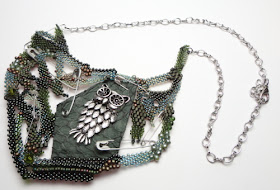 |
| Summer Flower by Aurelio Castano |
Being Latino, I was always curious on how to put intense color to my metal designs, tried Enameling, chemical and heat oxidizing, but I did not obtain the vivid color palette I was looking for. I tried beads as accent to my jewelry work, first large semiprecious beads, and then little by little the beaded work became more visible in my designs, until one day the metal became so minimal that it almost disappeared and the beads took over.
 |
| Native Barrel By Aurelio Castano |
I Think I made the transition at the right time. Beads have become one if not the only sources of happiness and therapy for me as well. When I first became disabled, I thought Cool; I will have more time for arts and crafts projects. Boy was I wrong. With pain in most of my body, there is very little that one is capable or desires to do. Luckily for me, I discovered Beading a few years into my chronic pain journey.
The great thing about Beading is that it lends itself to doing just a little bit each day, it is not exhausting, Plus when I finish a piece it makes me happy and gives me an enormous sense of accomplishment.
Making beautiful Bead work I have been able to continue a designing career that otherwise would have ended. Doing my bead work at my own pace makes things much easier and I don’t have to force my body in anyway. Once I finish a piece I take pictures I am able to upload to social media like Facebook. This way I am able to interact with other artists and public in general, getting feedback about my work, but more importantly it gives me the opportunity to stay in contact with people which otherwise I would not be able to, due to the nature of my illness.
My work has been published in magazines and participated in bead exhibitions, which is not necessarily everyone’s plan but it is a hint that shows that beading not only makes a good therapeutic exercise but also a great opportunity to continue having a descent fun living despite the aches and pains.
I am not a therapist and I don’t intend to be, that is why I am going to concentrate on what I know has helped me by making 5 important steps to make your beading experience pleasant and rewarding.
1- Investigate whether you want to or can do Beading or Bead stringing. Here is the differences to Beading, bead weaving or bead work: http://en.wikipedia.org/wiki/Beadwork
Bead stringing: http://en.wikipedia.org/wiki/Bead_stringing
2- Once you decide which technique would be better for you, and easier for you to do, taking into consideration your abilities and restrictions, plan your design, start very simple. Remember that you should enjoy this experience. Buy only the necessary materials for your project. It is very easy to over spend when you are in a bead/craft store if you don’t have a plan.
3- Create a comfortable atmosphere where you can sit comfortably, and enjoy your time. Make sure you have a good light, make sure that you have all your tools handy and all your materials available.
4- Be resourceful, there are hundreds of free tutorial videos online.
http://www.youtube.com/results?search_query=bead+stringing+techniques&sm=1
http://www.youtube.com/results?search_query=beading+tutorial&sm=1
If Bead weaving is your technique of choice you can come to our Bead Mavens blog spot where you can find many ideas, if you are a beginner. I recommend checking the back to basics that Mikki Ferrugiaro posted recently. Here are the links:
http://beadmavens.blogspot.com/2014/01/back-to-basics-month.html
Check all of January 2014 for the Back to Basics Tutorials
5- Whether you make your designs for yourself or as gifs, always be sure to do it for your own enjoyment, remember this is a therapy for you. Through experience I can say that the reward can make you feel better and happier, something that no medicine can do. And if you do it the right way, believe me there are no side effects from this.
So, if you are suffering from a chronic illness, don’t hesitate to grab those beads and cheat on those dreadful painkillers and their side effects.
Lol, do take those meds as well.
Inspirational reading:
http://voices.yahoo.com/my-therapeutic-experience-beads-dealing-with-5300217.html
http://www.hannahwilsonjewellery.com/Bead%20Therapy.html
http://www.beadsofcourage.org/pages/beadsofcourage.htm http://www.stjude.org/stjude/v/index.jsp?vgnextoid=20592b2a570c9310VgnVCM100000290115acRCRD&vgnextchannel=a0afc9c154e14310VgnVCM100000290115acRCRD





